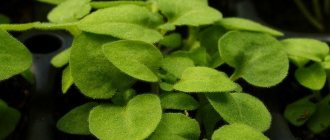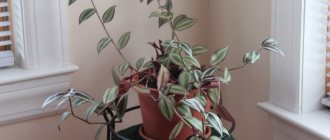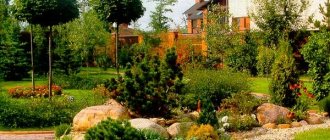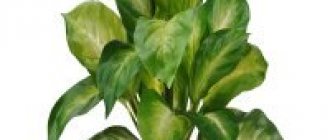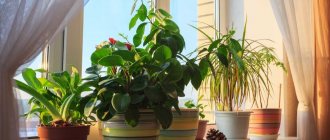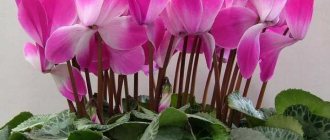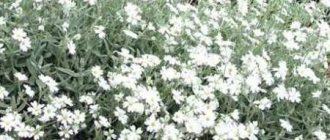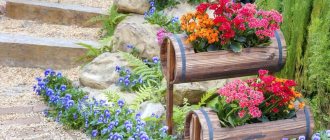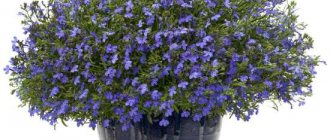Blooming for more than one year
Ampelous perennials make life much easier for the gardener, since they do not need to be sown every year. It is enough to provide them with certain wintering conditions. These include:
- Scaevola pleasant overwinters in a humid room at a temperature not exceeding 10 °C;
- dichondra overwinters with additional lighting and rare watering;
- bacopa will not bloom in winter, but if watered moderately, it will overwinter comfortably;
- Campanula equifolia is an ampelous perennial that blooms all summer. Tolerates winter together with indoor plants. Popularly called “bride and groom”;
- perennial lobelia will overwinter if it is covered and not allowed to get too cold;
- geranium can also overwinter in an apartment; with moderate watering and light, it blooms in winter.
Plants for hanging pots
Campanula equifolia, fuchsia, and ampelous begonia are well known to lovers of indoor plants. When hung on balconies and verandas in the summer, these chic representatives should still receive appropriate care. It is necessary to loosen and moisten the soil, protect it from direct sunlight for a long time. For long-term flowering of Campanula, faded flowers are removed in time.
Outdoors in summer, annuals are used: petunia, snapdragon, viola, especially climbing varieties, nasturtium. These plants can be planted without being combined with other plants. The compositions are composed of geranium and petunia. Begonia and fuchsia are combined with lubelia. Petunia is complemented by verbena or dichondra.
Indoor
Ampel flowers for hanging pots, hanging in multi-colored cascades in the apartment, can make even the simplest interior attractive. Low-growing shrubs are also well suited for home growing and can become an excellent backdrop for climbing frames. The main thing is correct placement and selection of a variety suitable for indoor conditions.
Jasmine
Constantly blooming indoor jasmine is characterized not only by the interesting shape of the inflorescences, reminiscent of a shield, but also by its incredible aroma. The bush can be climbing or erect. The color of the petals is varied - from white to scarlet, depending on the variety. The culture is light-loving, but can die under the influence of direct sunlight.
Related article:
Lantana Camara lubava: planting, propagation and care
Nertera
The second name of the culture is coral moss. This is a rather unusual indoor plant with small, inconspicuous flowers. Its value lies in the abundance of small bright berries, which appear at the end of the flowering period and form a continuous coral carpet on the surface. Nertera looks especially attractive in wide, shallow flowerpots. To maintain its decorative appearance, it needs good, but not too bright lighting. Direct sunlight causes burns on the leaves.
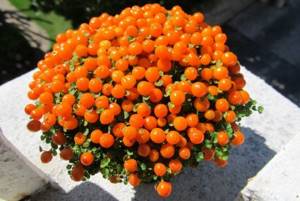
Succulents
Ampelous succulents are very succulent, so they are heavy and require durable flowerpots with reliable fastenings. They love diffused light or partial shade, high air humidity and slightly moist soil. Shoots and leaves are easily damaged and are sensitive to negligence and dust.
They form long thread-like shoots. But there are also low-growing species, for example, cacti. It is recommended to create cascades from them, installing them on shelves at different levels, as well as floor or tabletop sculptures.
Related article:
Schisandra plant: photos, types, cultivation, planting and care
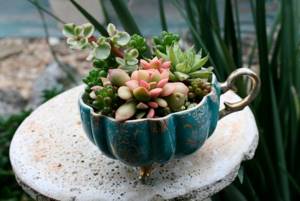
Fuchsia
A bright, beautiful ampelous perennial with a wide variety of shapes and colors. Requires moderate lighting. Under the bright sun, development and flowering rapidly deteriorate. Soft partial shade without drafts in a warm room is best.
As it grows, it branches heavily and requires constant pruning. Overheating of the root system is dangerous for fuchsia, so light ceramic pots with thick walls are used for planting.
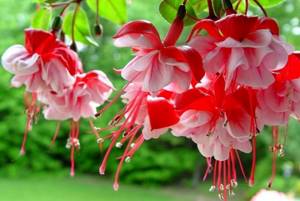
Hoya
Evergreen vines (another name is wax ivy). Young stems are purple in color and not covered with foliage. Gradually they become lignified and umbrella inflorescences appear on them. Hoya grows well on the windowsills of eastern and western windows; on southern ones it needs to be slightly shaded. But the lighting must be sufficient, otherwise the color will fall off and a new one will not appear.
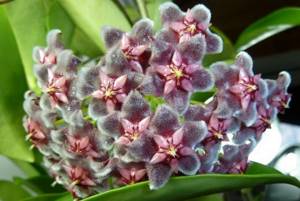
Types of hanging plants
The name of these plants comes from the German word Ampel - hanging flower vase.
Petunia
It can rightfully be called the “queen” among all hanging plants. It is rare that a gardener does not plant it on his plot.
Petunia - the queen of ampelous plants
Surfinia
Due to its extraordinary similarity, surfinia is often called ampelous petunia.
The beauty of surfinia will fully manifest itself with good care.
Pelargonium ampelous (geranium)
Until petunia became so popular, geranium was on the throne of the “queen” of hanging plants.
Geraniums have long been decorated with balconies, gazebos and garden plots.
Even in Soviet times, our mothers and grandmothers decorated balconies, gazebos, and garden plots with it. Even today it is very popular due to its decorative flowering, drought resistance and phytoncidal properties. Pelargonium is thermophilic and sun-loving. Prefers loam and moderate watering.
Begonia
An extremely unpretentious plant, which is loved by all gardeners no less than petunias and geraniums.
Unpretentious begonia loves the sun
Lobelia
This hanging plant thrives in both sun and partial shade.
A container with lobelia can be placed in partial shade
Verbena
An extremely unpretentious hanging plant. Flower growers love verbena for its long flowering time - from early spring to autumn.
Verbena will delight you with long flowering
Diascia
Loves sun and light sandy soil.
Diascia is demanding on soil moisture
She, like verbena, does not tolerate excess nitrogen. In hot, dry summers, diascia requires abundant watering.
Dichondra
Decorative deciduous ampelous plant. People also call it “silver” waterfall.
Dichondra is charming in company with other hanging plants
Looks great in combination with other plants in hanging pots and baskets. Loves partial shade or sunny places, prefers loamy soil.
Bacopa
It is a perennial plant, but is often used as an annual plant.
Bacopa grows equally well in sun and partial shade.
Extremely loved by Europeans, but little known in our country. Bacopa is native to South America. As long as it's warm outside, it will bloom. Loves sunny places or partial shade, does not tolerate waterlogging and drying out of the soil.
Nolana is weird
Nolana is relatively unpretentious and drought-resistant.
Nolana strange is unpretentious and drought-resistant
Blooms with lilac or blue flowers. The shoots of the plant can reach half a meter. To place it, choose a place protected from the winds.
Valued for its very abundant flowering.
Scaevola pleasant will delight you with abundant flowering
Campanula equifolia
This is a plant of the bellflower family, popularly it is also called “bride and groom”.
Campanula equifolia will be good in partial shade
It has thin creeping stems about 25 cm long. During the flowering period, the plant is completely covered with scatterings of white, purple or blue star flowers. For long and abundant flowering, it is necessary to promptly remove wilted inflorescences. Grows well in light shade, prefers moist, loose soil.
Fuchsia ampelous
The cups with curved edges, painted white and pink, give fuchsia flowers a special grace.
Graceful fuchsia prefers partial shade
She doesn't like the scorching sun. Prefers constant moderate soil moisture. Falling (ampeloid) fuchsia blooms from early autumn to September.
We have listed only a small part of the entire variety of hanging plants
If you still don’t have one at your dacha, maybe it’s time to pay attention to their advantages: they are decorative, take up little space, and are easy to move if necessary. However, remember that many hanging plants lose their decorative appearance if the basic growing conditions are not met.
Ampelous flowers for pots - unusual solutions
The fashion for vertical gardening is gaining momentum. Ampelous flowers for pots allow you to fill the space at eye level with bright colors. It is beautiful, stylish and extremely impressive. And February is the time to think about creating a hanging garden!
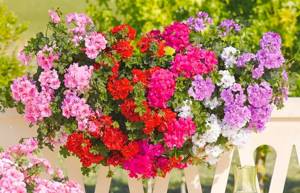
There are a great variety of hanging flowerpots on sale. There are samples of all colors, shapes and sizes: round, square, oval; ceramic, wooden and plastic; with a cut and beveled edge (for hanging close to the wall); “pot-to-pot” design that protects the soil from overheating and waterlogging. Don't want to spend extra money and care about the environment? In this case you can use creatively:
- old wicker baskets - line the bottom with waterproof material;
- wooden boxes for vegetables and fruits - hang on chains;
- chandeliers and sconces - with flowers placed in shades;
- kitchen and garden utensils - a sieve, a kettle, a stewpan, a colander, a bucket, a basin, a watering can;
- coconut halves, old shoes, and much more that has a durable bottom and is easy to drill holes for fastenings (for hanging).
Ampelous flowers should remain decorative throughout the season, be resistant to bad weather and be content with a small amount of planting substrate. The easiest way is to use annuals - then there will be no question of where to put the plants after the onset of cold weather and the end of the summer season.
We offer hanging flowers for pots, which are easy to care for. Top 10 from Becker:
1. Sequence ferulolifolia – drought-resistant, cold-resistant, undemanding to soils. Blooms in mid-summer and blooms until late frosts. It has lacy leaves, flexible creeping shoots and numerous flowers resembling the shape of a daisy.
2. Hybrid verbena – undemanding to placement conditions and watering. It blooms in waves, so it is better to plant it together with other hanging plants - cineraria, pelargonium. You can make your own planting mixture from peat, river sand and garden soil - in equal proportions.
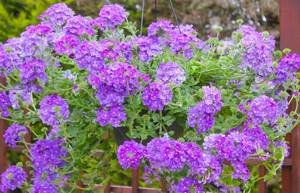
3. Diascia is a charming plant with strongly branching shoots and small crimson flowers. Looks great in tall containers and hanging planters. 2-3 plants are planted in a large container.
4. Ipomoea sweet potato is a climbing plant from the Convolvulaceae family. During the season it grows up to 30 cm in height. Scourges can reach 1.5-2 meters. Not all varieties are capable of flowering. However, the leaves themselves are of decorative value - large, carved, serrated, on thin long petioles. Color varies from light green yellow to purple and burgundy.
5. Lobelia erinus is covered in July with small star-shaped flowers of blue, blue or pink color (depending on the variety). Blooms until September. Resistant to wind and rain.
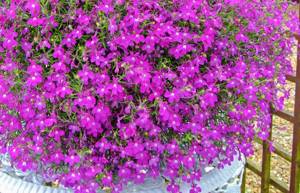
6 Purslane grandiflora - forms compact bushes, densely strewn with white, red or purple flowers. Buds form before late frosts. The flowers do not lose their bright colors even under the scorching rays of the sun.
7. Viola Vitrocca (pansy) - decoration for any hanging flowerpots. It is unpretentious and has many different varieties with different petal colors. Bushes can be placed in small containers. For example, build a multi-level cascade from coconut halves or plastic bottles cut off at the neck.
8. Yellow Zelenchuk (clamweed) – resistant to diseases and insect pests. It loves loose, moist soils, so it should not be planted in fabric or straw pots.
9. Pelargonium ivy. Forms cascading shoots up to 90 cm long. Flowers are collected in shield-shaped umbrella baskets. The color is white, pink, lilac and red. There are new hybrid varieties with salmon and cherry colors (Mustang, Pygmy).
10. Silver Dichondra is a perennial from the Convolvulaceae family. Forms a falling cascade up to 1.5 meters long. The flowers are small (up to 3 mm), white, purple or light green in color. The leaves have an interesting cupped-round shape.
And of course, hanging flowers for pots include ivy. They can climb vertical surfaces and form cascades. There are many varieties - with different shapes and colors of leaves, including variegated ones. Ivy is unpretentious and decorative all season long. They can grow in containers of any size from any materials. The only thing they don’t like is the midday rays of the sun. It is better to place ivy in partial shade.
And for those who love flowers and are ready to learn all the intricacies of care and cultivation, in our “Floriculture” section you will always find the most up-to-date tips on growing flowers for both beginners and experienced gardeners, articles on garden decoration, sowing features, as well as many other very useful materials.
Compositions
You don't need to be a designer to create a beautiful composition. The main thing is to choose the right varieties. Plants should complement each other. Compositions can be different: from a simple combination of different colors to professional selection. For example, you can plant yellow, red or orange petunias in one pot.
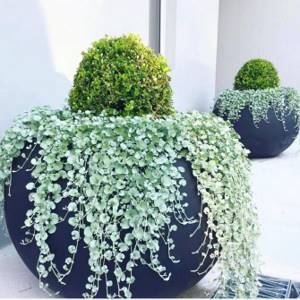
Composition of creeping
In general, hanging plants have many colors. The main thing to remember is that the plantings should be of the same height so as not to shade each other.
In open soil, you can create a picture with the help of ampelous outdoor plants. Suitable creeping plants that cover the soil include:
- Monkey loosestrife is a perennial plant that grows quickly as the weather warms up, covering the flower bed. The leaves are round, the flowers are small yellow, they can climb up and decorate the wall with their greenery;
- Lesser periwinkle is also a perennial, which in the spring will decorate its lush green shoots with purple flowers;
- dichondra will cover the carpet with long shoots and decorate the flowerbed.
Note! Old things that can be given a second life are suitable for decorating the garden as pots and flowerpots. These could be old carts, barrels, baskets, shoes
For a dacha, hanging plants can decorate not only the site, but also braid a fence, a gazebo, and small structures (shower, cellar, outbuildings).
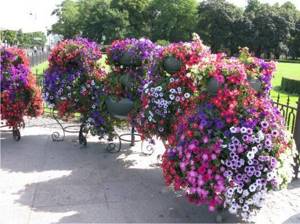
Even just placing pots along the path will become a decoration and will lift the spirits of both guests and owners
For your information! The more care and attention is invested at the beginning of a flower’s growth, the brighter and longer it will delight its gardener.
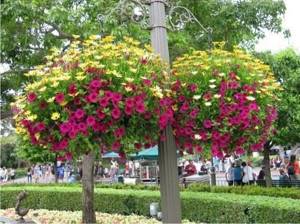
Contrasting combinations
For mixed compositions, you can combine different flowers, or you can plant the same type of different flowers. Pelargonium, petunia, nasturtium, fuchsia, and verbena will be excellent neighbors. They feel great in the company of other plant species. When creating a composition, you can play with:
- in color, choosing contrasts: white petunia and red pelargonium, blue lobelia and yellow begonia, fuchsia and white bacopa;
- in tiers. You can decorate the wall in tiers with colored balls. In such single pots, petunia, bacopa, lobelia, bidens will bloom in a spherical manner;
- shape and height. For example, dichondra, whose lashes will hang down, fits perfectly next to petunia. Fuchsia flowers fall down, and nasturtium may appear in the center.
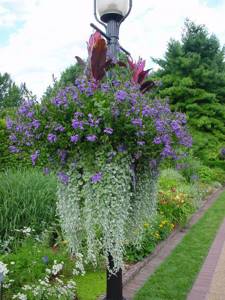
Tiers in one pot
Almost all types of hanging plants are suitable for creating hanging gardens; the main thing is to remember that the smaller the pot, the more often the plant requires watering. Easy-to-care, hanging flowers for the garden will lift your spirits until the coldest weather.
Flowers for hanging pots: decorative and more
The desire to decorate not only the ground part with flowers, but also the upper tiers of the site has led to the popularity of hanging versions of pots. In this position, the most suitable flowers for pots are hanging ones. It is the cascading floral mass that creates an interesting decorative effect.
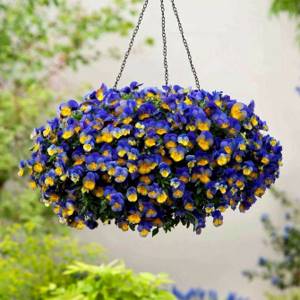
The upper tiers of the garden plot can be decorated with flowers in hanging pots.
Those who want to not only decorate the area around the house, but also get benefits, can plant... berries and vegetables in hanging pots. Strawberries are a great option. During the flowering period, it creates an original green cap of large leaves, decorated with white or pink flowers. The berries ripening on the stems fall, forming a strawberry “rain”.
Cucumbers of all types, as well as long-stemmed tomatoes, can also be useful decorations for your garden. Chili peppers look original in hanging flowerpots. It needs to be planted densely, then both the green mass and the ripening fruits will look more impressive.
Note! Growing conditions in open ground and in pots are significantly different. In the latter case, the vegetables may not have enough organic matter due to the small amount of soil
It is necessary to periodically feed vegetables and berries in the pots. You can plant not only flowers, but also strawberries in hanging pots.
For those to whom the sense of commercialism is completely alien, it is worth using hanging flowers for pots. These are plants that are characterized by drooping or creeping stems. The flowers are small or medium-sized, densely located on the stems. Among the ampelous species there are few non-flowering species.
How to distinguish ampelous petunia from bush petunia
Bush petunias are the least demanding to care for; just pinch the top. This variety is the most common and includes several varieties of different shades. The shape resembles a small tree with a cloud of red, purple or variegated crown. These representatives reach 30 cm in length, with the stems growing upward. There are terry, small-flowered and large-flowered varieties.
Ampelous petunia - growing in hanging pots
Features of the bush variety:
- rounded green shoots;
- the roots lie shallow in the ground;
- the entire green mass of the plant is covered with a small fluff;
- each variety is distinguished by large flowers, the diameter of which is at least 10 cm;
- the peduncle is short, the stems are erect;
- The transition of shades on the flowers is smooth, gradient. There are contrasting inclusions on the edges;
- the edges of the buds can be with sharp teeth, wavy or corrugated;
- after the end of the flower formation period, the seed box remains.
Note! Bush petunia does not require shaping; it is enough to plant it correctly, pinch it and trim it.
Ampel nasturtium
Nasturtium is distinguished by its decorative originality, having flowers of an original shape and colored in red and yellow shades. Flowering is pleasantly complemented by contrasting leaves. Nasturtium does not grow indoors and is an annual garden plant.
Many flower growers have paid attention to its diversity and willingly cultivate it. Depending on the variety, nasturtium can be more or less climbing, often twining, or vice versa, similar to a herbaceous bush
Although this flower requires a fair amount of sun, it can live in partial shade. Often grown in garden vases, it also looks elegant hanging. Ampelous nasturtium produces quite long shoots, more than a meter. The beautiful look comes from the combination of red, orange and yellow flowers. But there are also terry varieties. The plant is easy to sow and sprout, but this must be done in May, when frosts are excluded. This crop is unpretentious to the soil.
What flowers to plant
Verbena ampelous:
- leaves are dense, hairy;
- flower color - blue, purple, pink, red.
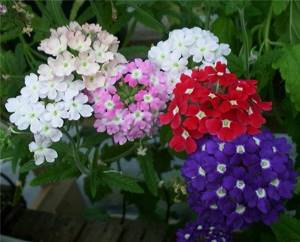
Variety of Verbena flowers.
This plant attracts butterflies and, according to ancient legend, serves as a talisman against ill-wishers.
Lubelia ampelous: small oblong leaves are practically not visible from under the abundant cap of flowers.
Flower color:
- blue;
- blue;
- purple.
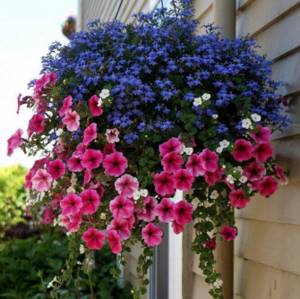
Breeders have not yet bred red lubelia! Don't trust enterprising, careless sellers!
Diascia:
- leaves opposite;
- dark green (glossy);
- flower color - purple, salmon, orange, pink.
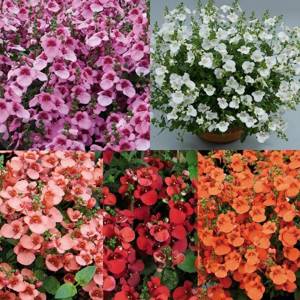
Their diameter reaches 20 cm. Shoots grow 30-50 cm, depending on the variety.
Fuchsia ampelous: cascading stems decorated with flowers of white-pink, scarlet or lilac-violet color.
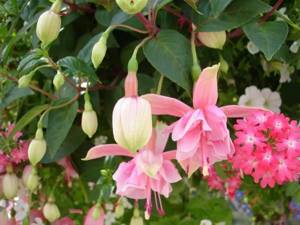
The flower reacts sensitively to changes in location, so it is advisable to immediately place the basket or flowerpot with fuchsia in a permanent place.
Moorish bindweed: blooms in all shades of blue all summer without interruption. It is absolutely unpretentious to the soil.
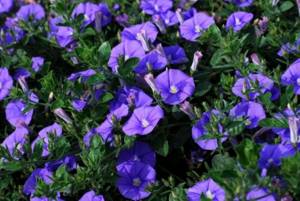
With proper care, flowering lasts until the first frost.
Scaevola has that are quite large (up to 9 cm);
Flower color:
- blue-purple;
- lilac;
- blue;
- white.
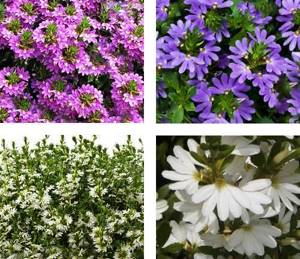
According to the shape of the flower, all the petals are asymmetrically concentrated on one side of the tube and form a kind of fan.
Ampelous petunias: beautifully flowing vines reach 80 cm.
Plant varieties such as “Snow Queen”, “Dubble Cascade”, “Ramblin” have a pleasant aroma. Such a variety of petunia as “Black Velvet” is beautiful and unusual. We wrote more about petunias here.
The stunning deep black petals appear velvety and form a flower 8-9 cm in diameter.
Ampelous fern: openwork leaves need regular spraying. The width of the leaves can reach 80 cm.
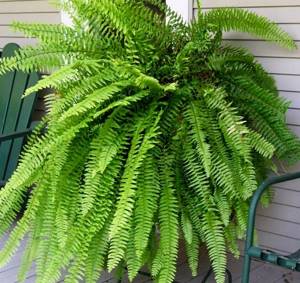
Prefers acidic soil.
Ampelous begonia (Limming's Begonia): the hanging shoots of the plant reach 30-50 cm. The leaves are light green with a yellowish tint.
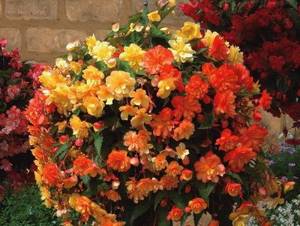
The color of the flowers varies from light red to coral.
Return to content
Advantages of hanging gardens of annual flowers
One of the main advantages of hanging gardens is their durability. Most types of hanging plants bloom in late autumn. Some of them can overwinter in a warm room and bloom again in the spring. They can be propagated in different ways.
Hanging plants save garden space. They can be placed in a small yard, made into stylish compositions, or combined with small pools or ponds. If there is no yard at all, then hanging plants in pots can be an excellent decoration for a terrace, gazebo, balcony or windowsill.
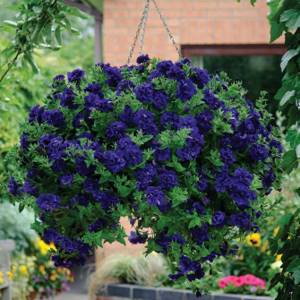
Pots with bright flowers look beautiful from any angle
Any flowers decorate and enliven the place where they are located. Ampelous flowers in pots make it possible to create original, unique compositions that can please the eye throughout the summer and even in winter.
Features of ampels
The main advantage of garden plants in pots is the ability to change location. They can always be moved to places where there is something to hang them from, from gardens and home areas to balconies, verandas and interior spaces.
The main disadvantage is the need for more thorough and consistently regular care. But, despite this, most gardeners grow hanging plants, creating very beautiful and original compositions.
Related article:
African daisy gatsaniya
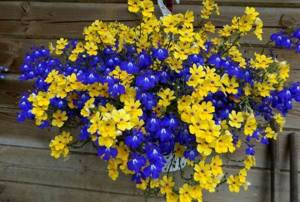
In order for the ampels to look attractive throughout the season, it is necessary to take into account the requirements of a particular plant for environmental conditions. First of all, this concerns lighting and strong wind loads when located outdoors. Here are some recommendations you can use:
- geraniums and chlorophytums can grow in the sun; ampelous representatives of begoniaceae and bellflowers prefer to remain in the shade;
- strong winds are undesirable for plants with thin, elongated stems and numerous large flowers, but are not too harmful for crops with a predominance of leaves (for example, ivy) or with short dense shoots (ageratum, verbena).
Special attention should be paid to the pot. The main requirements are strength, capacity and the presence of drainage holes. It is also necessary to take care of the reliability of the fastenings.
The most attractive are compositions created in one pot from different cultures. Flowering plants hanging from a pot look especially good next to low-growing shrubs.

Ampelous petunia and alyssum
How to make a composition of ampelous plants
From hanging flowers you can grow a magnificent composition and even a real masterpiece of landscape design. Creeping plants will cover the soil with a “carpet” and create a background for the composition. Common loosestrife, dichondra and small periwinkle are suitable for this purpose. You can grow a dense “forest” from succulents.
Larger multi-rosette flowers should be placed in the center of the composition. They are used to grow shapes: a heart, a star, an animal’s face, etc. You can choose one of the brightest flowers and make it the center.
Falling plants must be grown at a certain height: they must rise above the rest of the composition. Flowerpots with high legs can be placed in the center or on the sides. Hanging flowerpots will decorate the walls. Climbing and climbing plants are ideal for decorating arches, walls, roofs and other vertical surfaces. They can even be woven into outbuildings.
The composition can be supplemented with foreign objects, for example, old baskets, boots and any other unnecessary things. You need to show your imagination: experiment with shapes, combine different shades, add unexpected details, place flower pots on different tiers.
Additional Information! Arches and walls can be decorated with climbing roses. But these flowers are very whimsical.
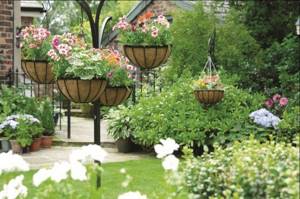
Hanging pots and vases
Placement of hanging gardens: garden design style and color concept
Hanging gardens are an original decoration of a summer cottage. They need to be cared for in the same way as a regular flower bed, depending on the needs of the plants. A hanging garden is a flower ensemble consisting of 5 or more plants of different species growing in hanging boxes. To create a hanging garden you will need many trellises and beams located at different heights. All flowers in the composition should receive the same amount of light, moisture and fertilizer. You should not plant light-loving and shade-tolerant flowers next to each other, as well as annuals and perennials.
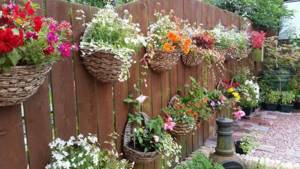
Hanging Garden
Hanging plants for the garden will add a touch of luxury to even the most inconspicuous area. The hanging composition looks like a light cloud hovering over the garden. It is necessary to care for hanging flowers just as carefully as for ordinary ones.
Features of application in design
Ampelous petunia - growing in pots and care
It is quite logical to place these flowers in places where direct rays of the sun do not penetrate. Their location directly under the ceiling, on stands, near large pieces of furniture, against the backdrop of large trees is considered successful.
Where are ampelous plants used?
The fashion of decorating walls with carpets and pictures is long gone. Bare walls sometimes evoke boredom and despondency. Flowers hanging on the wall or ceiling will help get rid of this mood. Skillfully and tastefully selected plants will create comfort and a beautiful view.
Placement of hanging gardens: garden design style and color concept
When arranging hanging vases with flowers, you need to try to choose them according to size, color, and shape. The most creative look are entire hanging gardens, consisting of a wide variety of plants and devices.
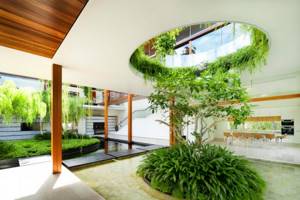
Decoration of hanging gardens
It’s good if the florist himself understands the world of plants and agricultural technology and has enough time for this. Although it is no secret that there is such a specialty as a landscape designer who provides decorative landscaping services. He will help you select plants, draw up a plan, and arrange all the components in a certain style.
As for styles, the most popular are the following:
- architectural. Plants are combined with building elements: walls, pillars, lanterns, roof;
- Baroque, or palace. Elements such as openwork, stucco, statues are used;
- art. Fills the garden with various decorative components: fancy figurines, parts of furniture, unnecessary dishes;
- brutalism. Based on the contrast between graceful and rough, light and dark, large and small;
- country. Involves the use of accessories from “folk life”. It is distinguished by its brightness and variegation;
- classical. It will appeal to those who love everything symmetrical and correct.
Note! To decorate any style, designers often use petunia and bacopa. These plants are distinguished by stable flowering, a variety of colors, and easy care.
Advantages of hanging gardens of annual flowers
Russia has a varied climate. And here it is advisable to use annual crops for landscaping.
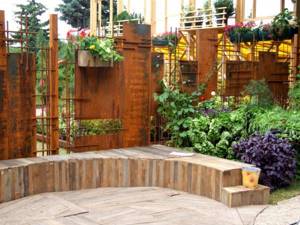
Composition of ampels
This allows you to create countless options in color, height, shape, style, composition. Also, the gardener will not have to take measures to preserve the plant in winter, and he will be able to think through the design for next year in advance.
Thus, hanging plants can be used everywhere. They will make any interior unique and interesting.
Bacopa
Very loved by European gardeners, but little known in Russia. Recently, it has been rapidly gaining popularity among lovers of landscaping loggias and summer pavilions. The plant has about 100 varieties, most of which are aquatic species.
Bacopa ampelous is known to most gardeners as sutera. Its homeland is considered to be Africa and the tropical part of South America.
These ampelous flowers have an attractive appearance. Its drooping shoots are very densely strewn with small flowers of pink, white or blue.
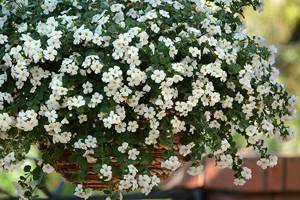
Sutera loves abundant watering and requires frequent moistening. Perhaps, this is where all the features of caring for her end. Otherwise, she is completely unpretentious. Bacopa grows equally well both in partial shade and in full sun, and is not afraid of temperature changes.
It goes well in flower arrangements, but alone it can compete with any ornamental plant.
Rules of care
Breeding ampels and the rules for caring for each of them depends on the characteristics of a particular culture. The approach to each plant must be strictly individual. But there are general rules for growing in a hanging container. You need to take special care of outdoor flowers, since under the influence of the sun the substrate in pots dries out quickly, and abundant watering with the drainage of excess water through the drainage holes leads to an accelerated removal of useful substances. In addition, most hanging flowers require regular sanitary and formative pruning to maintain an attractive appearance and a long flowering period.
Related article:
6 types of enkianthus: planting and cultivation secrets
Watering, fertilizing
The ampels need to be watered moderately but often. If located outdoors, it is recommended to carry out such an event daily in the morning or evening using settled soft water. In any case, the volume of water is clearly dosed taking into account the size of the pot. It is also important to have a thick drainage layer and holes in the bottom for the outflow of liquid in case of excess.
Feeding, like watering, must also be regular in order to promptly replenish nutrients washed away by increased amounts of water. Each crop requires its own type of fertilizer, but for flowerpots it is recommended to follow this scheme:
- during active growth, nitrogenous organic matter is used;
- during the period of budding and flowering - preparations based on potassium and phosphorus.
Related article:
Irises in the garden: site design ideas
Fertilizers are applied 2 times a month in quantities dosed according to instructions. An excess of nutrients can lead to wilting and subsequent death of the plant.
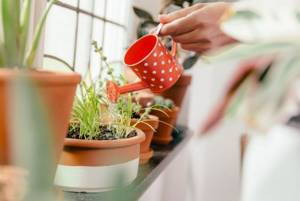
The application of water and liquid fertilizers is carried out using a special watering can with a long curved spout. Additionally, spraying from a spray bottle is required, especially in extreme heat. Indoor ampels are sprayed more often in winter than in summer, since heating radiators greatly dry the air in the room.
What varieties of hanging trees are best to plant on the site?
Let's look at some garden hanging plants that bloom beautifully and are easy to care for.
Option #1 – hanging begonia
A wonderful plant with small scarlet or bright red flowers on delicate, flexible and long stems. The flowers resemble small chrysanthemums. This is a rather whimsical plant that does not tolerate heat at all and needs frequent watering. Begonia should not be placed in bright sun; you need to choose a shaded corner for it. If summers are too hot in your area, this plant will not be suitable for the garden.
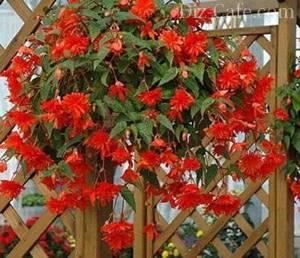
If the ampelous begonia feels good in your garden, it will delight you with abundant flowering. Even one pot with such a beauty will decorate a gazebo, veranda or terrace. Try to keep the plant out of direct sunlight
Option #2 – pelargonium
One of the most unpretentious plants is pelargonium (or geranium). Geranium loves the sun, warmth, and is not afraid of drought. The plant will not disappear if you are away for a long time and there is no one to water it.
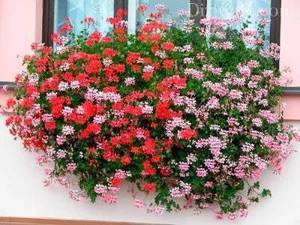
There are many types of pelargonium that grow well outdoors and indoors. Boxes with blooming pelargonium can be placed in any sunny place in the garden, under the windows. This plant also looks good in flower beds
Option #3 – lobelia
Lobelia is a hanging plant that is also well suited for the garden; it can grow in both sun and slightly shaded areas. Lobelia should grow in moist, humus-rich soil.
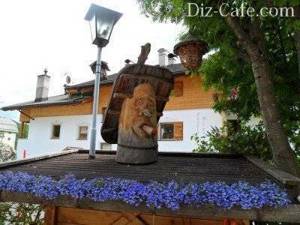
Using lobelia you can make a kind of “edging” for some garden buildings, or, for example, a fence
Option #4 – ampelous petunia
Ampelous petunia is known to everyone. Its bright, beautiful flowers of purple, lilac and red colors can be found in summer not only in gardens, but also as decoration for city balconies and cafe terraces. Petunia needs regular watering, a well-lit, warm place and fertile soil. It will delight you with its flowering until the onset of cold weather.
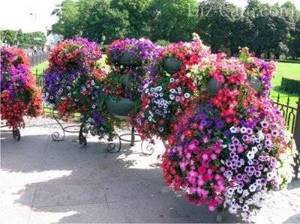
An option for decorating a path using a hanging petunia. Such two-tier pots on beautiful wrought iron stands are sold in flower shops, and the colorful flowers in them look simply luxurious
Option #5 – bacopa
Bacopa is a perennial, but in our country it is more often used as an annual plant. Blooms throughout the warm period, grows in sun or partial shade. The soil should be watered moderately so that it does not dry out or become overly moist.
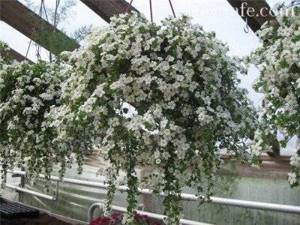
Bacopa is known for its ease of care. There are varieties with white flowers - as in this photo, as well as with lilac and violet colors
Flowering hanging plants are, of course, favorites among those who like to decorate their garden. But there are also non-flowering varieties of ampels that can transform any unremarkable or even dull place into a pleasant place to relax.
Option #6 – dichondra
Ampelous dichondra is a new product in our flower market. This is a deciduous plant whose shoots can reach one and a half meters in length. Dichondra leaves are small and round in shape. May be green or silver. The plant is perfect for both vertical gardening and for creating a carpet on the ground.
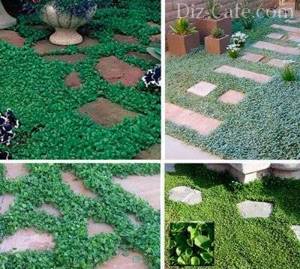
This is the kind of carpet that dichondra can form on the ground. You can place the shoots symmetrically, directing them along the tile line
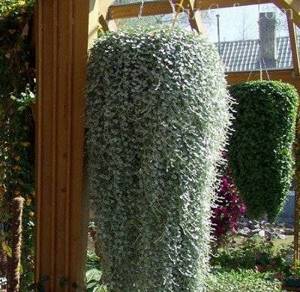
Dichondra, hanging from a flowerpot, looks quite unusual. This cascade of green or silver lush greenery will add charm to any space in the garden.
There are many types of hanging plants, this is only a small part of them. All of the above plants grow well in our gardens, they do not require special care, but turning the site into a wonderful corner with their help is not at all difficult
You just need to pay attention to them, care for them, and water them in a timely manner.
Garden (street)
Ampels are used outdoors in single versions or to create hanging gardens. The second option has long become an integral part of landscape design, so all kinds of devices for forming complex and original structures are available for sale. Below are the names of hanging plants for pots, suitable for outdoor landscaping.
Related article:
How to store bulbous flowers in winter
Begonia
This flower crop in its ampel form has hanging stems, completely covered with double or flat flowers of medium or rather large size. Shade-tolerant, resistant to temperature fluctuations within +15⁰С…+30⁰С, flowering period is 5 months (May–September). Reproduction methods - tuberous or cuttings. Can be grown indoors, but with a mandatory rest period.
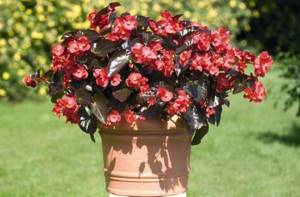
Verbena
The most undemanding of the hanging flowers for pots and one of the most beautiful - with bright red inflorescences. The duration of flowering directly depends on the regularity of removing faded buds - with timely pinching, it blooms until frost. Propagated by seeds. It grows well in the shade and sun, but develops best in a completely open, illuminated place.
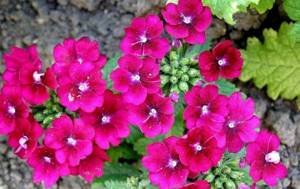
Viola
Shrub up to 0.5 m high, does not like strong sunlight. In partial shade it blooms until frost; in the sun the flowering period is significantly reduced. Propagated by cuttings or seeds. Prefers cool weather; in hot weather it is advisable to place it in a well-ventilated place, possibly in drafts.
Related article:
Dahlia needle
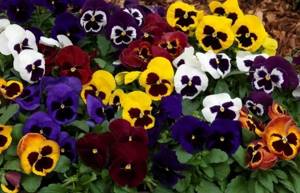
Read more about planting viola in the article
Loaches
Loaches in pots are another very common hanging plant. This group of fast-growing and abundantly flowering annual vines with flowers of different colors is optimal for vertical gardening.
Among the varieties, it is worth highlighting the rough grosgrain, gloxinia and sweet pea. Loaches easily reproduce by seeds; in nature, by self-sowing. Therefore, even an inexperienced gardener can grow them on their own. But when planting in a hanging pot, it is necessary to establish support and carefully form the crown.
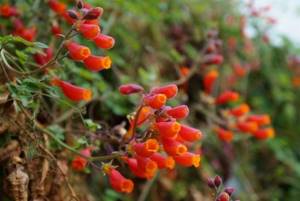
Visloporpnik rough
Diascia
A flower crop with long (up to 0.6 m) shoots covered with many not very large flowers of various colors. Prefers good light and needs constant moisture. Feeding, on the contrary, is not required, since the abundance of nutrients can lead to the death of diascia.
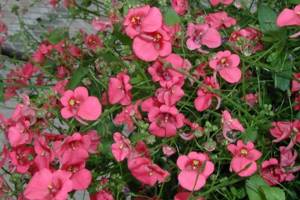
Pelargonium (geranium)
One of the most popular hanging flowers for pots, which is valued for its ease of care and many varieties with different colors. It has large bright inflorescences and rounded leaves with slightly pointed edges.
Related article:
Eustoma will decorate your garden
Fragrant pelargonium has slightly different qualities, the aromas of which are strongly pronounced and vary significantly depending on the variety. There are representatives with citrus notes, the smell of nutmeg, various fruits and herbs. But the fragrant variety has smaller inflorescences, which make it not as attractive as other types.
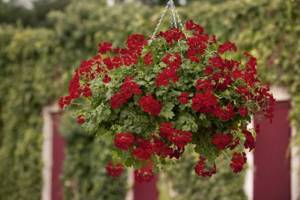
Petunias
Petunias are a “classic of the genre” in hanging floriculture. They are optimally suited for hanging cultivation, therefore they are most in demand in landscape design, as well as in the design of building facades, gazebos, platforms and almost any small architectural forms. Petunias are easy to care for and have a whole range of advantages:
- are not afraid of overheating of the root system under the influence of direct sunlight;
- can survive insufficient watering even in extreme heat;
- form a dense, beautiful crown;
- bloom throughout the summer season.
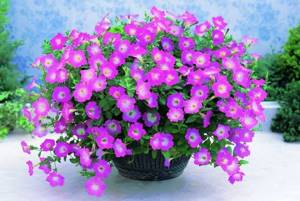
Petunias do not stop developing when the air temperature drops to +10⁰С. They are one of the few hanging crops that can be used for continuous cultivation. To do this, with the onset of cold weather, petunias are moved indoors, and in the spring they are transplanted into a new pot.
Related article:
The subtleties of growing petunias at home
Surfinia
Surfinia is a variety of petunia, which is classified as a separate species due to some biological differences. These flowers grow much faster, have longer shoots and lush blooms, and are resistant to rain and wind.
Surfinias grow many side shoots, giving the crown a cascade shape. Therefore, these are the only cascading flowers for pots that do not require shaping. The name "Surfinia" is registered as a Japanese trademark and refers to F1 hybrids. This means that she has the best properties of her parents and is significantly superior to them in everything.
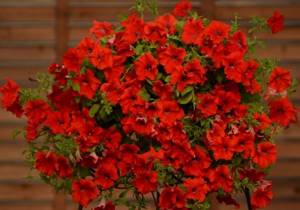
For the balcony
If you choose for a balcony, you need to consider which side it is on. After all, there are plants that love the sun, while others can only grow in the shade. You can even grow strawberries and wild strawberries on the balcony, but you need to carefully care for them, then they will delight you not only with their beauty, but also bring a good harvest.
Balcony decorated with petunia
After choosing the type, you need to take care of the decoration option for the balcony or loggia. It looks very beautiful when a bright hanging form grows in the center of the balcony, and curly ones hang along the edges.
For an apartment you should choose the following varieties:
- fuchsia. Her two-color bells will be able to decorate the balcony until frost;
- ivy. Looks very original in a flowerpot. This unpretentious vine can grow even in shady places;
- purslane. Another unpretentious plant. He is not afraid of rain and sun. There are varieties that close their flowers during rain, but in sunny weather they delight with their varied colors;
- Cyclamen feels good both indoors and on the balcony. The main thing is to water on time.
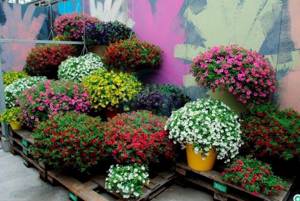
Composition for the balcony
Ampelous flowering plants are very beautiful and unpretentious. They look stunning in the garden and in planters on the veranda. In winter they can decorate your house and balcony. The importance of an ampel flower in landscape design is enormous. Ampelous - what does it mean? This means beauty, because climbing plants look very beautiful and are suitable for any composition. You can easily grow them yourself or buy them already blooming.
It doesn’t matter what flowers will decorate the garden or balcony, the main thing is that you need to love them. Under these conditions, violas and petunias will delight with their beauty for a very long time
Features and advantages of hanging plants for the garden
The names and photos of flowers for vertical gardening are numerous. In nature, hanging plants grow in tropical countries and spread along the ground. They are not suitable for growing outdoors. Planted in any kind of container, they are able to fully realize their potential.
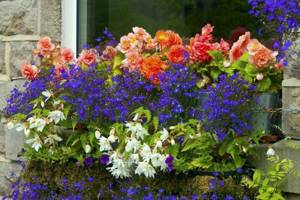
Luxurious hats with flowing shoots complement any home and garden interiors. The distinctive advantages of hanging flowers for pots are as follows:
- With proper care, these plants grow very quickly and reveal their decorative capabilities. They are able to bloom throughout the warm season, until frost.
- Hanging flowers are convenient to place anywhere in the garden, balcony, terrace or window openings. In addition, they are perfectly visible from any angle.
- A large number of varieties and varieties allows you to create special and picturesque compositions from them.
- Thanks to these plants, landscape design looks impressive, but does not require large expenses.
And the most important advantage of hanging flowers is that, due to their varietal characteristics, these plants do not require complex care
An important condition for their successful growth and flowering is good lighting and regular watering.
Among the whole variety of hanging plant varieties grown in flowerpots and flower pots, there are several that are most popular among flower growers.
Ampelous lobelia: an undemanding perennial
Lobelia (lat. Lobelia) is an undemanding annual that requires growing in a sunny place. The plant has many small flowers, the length of the shoots reaches 0.5 m. Lobelia blooms all summer and autumn. The color of the flowers can be blue, purple, red. Lobelia is propagated mainly by seeds.
The most popular variety Diascia (lat. Diascia) is a hanging plant, ideal for terraces. The soil for lobelia should be fertile, watering should be good, but waterlogging should not be allowed. Diascia blooms from summer to October. Propagation is carried out by cuttings and using seeds.
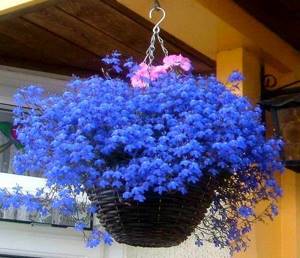
Lobelia (lat. Lobelia) is an undemanding annual that requires growing in a sunny place
Petunia
Perhaps one of the most popular plants among lovers of hanging flowers. It is loved for its huge variety of colors, unpretentiousness and long flowering. With good lighting and daily watering, petunia will delight you with its decorative effect until late autumn.

Due to the slow pace of development, ampelous petunia is grown in seedlings, which will allow flowering to occur already at the beginning of summer. Due to petunia's ability to grow quickly and become dense, you need to know exactly how many plants to plant in one container.
For example, in a pot with a diameter of 30 centimeters, two copies will be enough.
The best varieties of petunias for growing in pots: Explorer, Surfinia, Fortunia, Opera Supreme, Tumbelina, Avalanche.
Shade-loving ampelous flowers
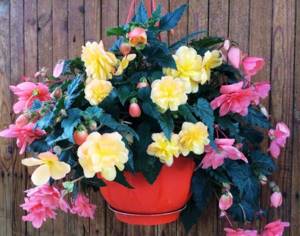
Varieties that love shade and do not like direct contact with the sun are indicated in Table 2.
| Name | a brief description of |
| Ampelous fuchsia | It grows only in the shade and likes moderate watering. The color of the buds is pink or white. Flowering occurs in early September and continues until October. |
| Begonia | The peculiarity of the plant are large inflorescences of different shades and neat small leaves. Grows in gardens in areas where there is shade throughout the day, in flowerpots and pots with a stand on a high stem. |
| Vanka wet or balsam | Annual. If you don't plant it in the shade, it quickly withers and dies. You can place flowerpots under the branches of fruit trees, thereby creating a lacy shadow. Abundant flowering is observed in the summer months, and if the weather remains warm outside for a long time, it lasts until late autumn |
Advantages
The advantages of designing a site using ampels are obvious:
Mobility. Flowerpots and other hanging containers can be easily swapped, creating new compositions each time and constantly maintaining a sense of novelty.
Versatility. You can decorate anything with hanging flower arrangements - a gray, nondescript wall, a modest terrace, a gazebo in the yard, and even vegetable beds. You can hang the pots on a stand dug into the ground or place them on an old, outdated barrel or cart.
Easy care. They do not require anything other than regular watering and occasional feeding. They grow like ordinary indoor house flowers.
Functionality. They can cover unsightly places, ugly structural elements, etc. In winter, they will become a chic addition to your home interior, insulated loggia, or winter garden.
Economy of accommodation. When suspended, they do not require additional space.
Visibility. A hanging flower bed is equally visible from almost any angle.
And, of course, decorativeness
They attract attention, create coziness, create an accent in the intended place, and complete the overall landscape idea.
How to arrange ampelous plants
Methods for decorating an area with hanging plants and flowers are subject to rules.
- The location of the vases should not interfere with movement.
- The interior or space of the garden is updated by changing the places of the flowerpots.
- A container with hanging plants can be placed on stands or fixed on a balcony, but in compliance with the rules of stability, using a reliable fixation.
- To create compositions, they use old things: movable or broken carts, bicycles, hanging kettles. This gives things a second life and makes the garden interesting.
Observing the general rules, you need to consider where a particular crop grows best: in the light or in the shade. Keep in mind the ability to withstand drought if regular care is not possible, and resistance to wind. First of all, you should take an interest in these parameters in order to extend the life of the ampelous “masterpieces”.
Features of growing such plants
Containers and flowerpots are convenient because they can be placed in almost any part of the garden or local area: along the edges of benches, at the entrance to the house, around the pool, along paths. If necessary, it is possible to rearrange the plants, replace them with others, and for this you do not need to dig up the bed or create a new flowerbed.
Various compositions of flowers in flowerpots look great in a cascade version: for this, create several levels of the same or different flower pots and plant flowers that are contrasting in shade or size. Shelves, steps, hanging structures, and stands are suitable for decoration.
Plants that live in confined spaces are somewhat different from flowers intended for planting in the ground. The differences relate to the following points:
- the root system of flowers feels great in a small space;
- plants are hardy and tolerate drought or excessive moisture;
- as a rule, flowering continues throughout the season - new buds grow to replace faded flowers;
- The bushy or trailing form of the plants is ideal for planting in pots, plant pots, flowerpots or containers.
Minimal flower care is another plus in favor of outdoor flowers.
Features of growing ampelous varieties
Hanging varieties are most often grown in hanging pots and boxes. When choosing a container for planting, taking into account the needs of a powerful root system and the ability for abundant flowering, preference should be given to pots and flowerpots of large volumes (from 5 liters for one plant). You can also allocate a separate area in the garden for petunia - a clearing intertwined with green shoots with multi-colored buds and flowers looks very beautiful. Cascading varieties are sometimes planted in open ground near poles and fences, resulting in bright supports entwined on all sides.
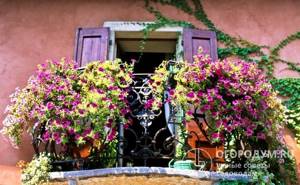
The best place for planting hanging varieties is in hanging pots and flowerpots, so the flowers not only look beautiful, but also do not interfere with other plants
Sunny or semi-shaded places, protected from strong winds that can damage thin long vines, which will lead to a decrease in decorativeness, are considered optimal for placing hanging plants In addition, varieties are divided into low-resistant varieties, whose flowers (and even shoots) do not respond well to getting wet, and hardy varieties, which are slightly susceptible to the negative influence of precipitation. Cascade varieties with thicker and more powerful stems are more resistant to external factors and various types of damage.
Experienced gardeners do not recommend planting ampelous petunia in flower beds next to other plants, as it grows rapidly, covering a large area and practically “drowning out” everything around it.
Care instructions
There are no significant differences in caring for the species of petunias under consideration. Plants require frequent watering, however, to avoid rotting of the roots and shoots at the base, you need to ensure that water does not stagnate in the soil.
An experienced gardener talks in detail about caring for cascading petunia "Typhoon Silver" in the following video:
In addition, the main agrotechnical measures include:
- feeding To obtain lush and long-lasting flowering, petunias must be fed periodically. To do this, it is best to choose complex water-soluble mineral fertilizers with a high content of potassium and phosphorus. During flowering, feeding is done at least once every 7-10 days;
- pruning and removing seed pods . To ensure that plants do not reduce the intensity of flowering and do not lose their decorative appeal throughout the season, it is necessary to promptly remove faded flowers along with the seed pods. If this is not done, petunia enters the fruiting phase, devoting all its energy to seed ripening, while new flowers are not laid;
- pinching _ Hanging and cascading varieties (unlike bush varieties) do not need to be pinched. However, if, in the event of a violation of the light or temperature conditions, the plant stretches strongly upward or the bottom of the stems is exposed, experts recommend tweezing or pinching the main growth points. This will stimulate the formation of new shoots and give the plant lushness.
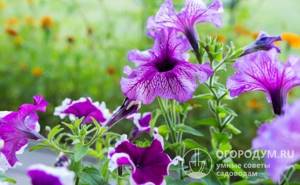
Dying flowers should be removed throughout the season to prevent seed maturation
Which type of petunias looks more attractive - every lover of these luxurious flowers will decide for himself. The varietal diversity of the crop allows you to create incredibly beautiful compositions not only in the field of landscape design, but also to originally decorate balconies, loggias, terraces and home interiors with these beautiful plants in hanging pots. Experienced gardeners often combine hanging and cascading petunias with bush petunias, expanding the possibilities for demonstrating their design abilities.
Examples of decorating a garden using hanging
The beauty of ampels is that they are easy to grow, or you don’t even have to grow them yourself, but buy already flowering plants in pots, or buy beautiful decorative pots and transplant seedlings into them - petunia, pelargonium, fuchsia, begonia.
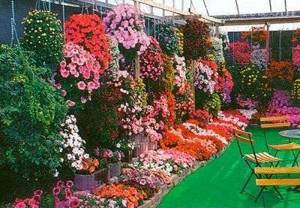
A beautiful wall of hanging plants arranged in several tiers

Garden composition of hanging lamps in country style. If there is no cart, you can use a decorative well, wattle fence
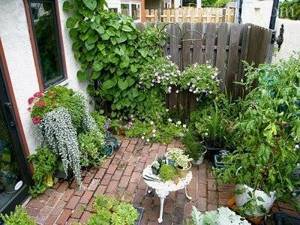
By placing ampels near the walls, you can create a cozy small courtyard
With the help of hanging plants you can beautifully decorate your patio, gazebo, or terrace. They will look good placed in tubs along garden paths. A beautiful combination can be formed by hanging plants and vines. Lianas can twine around a fence, the wall of a house or other building and serve as a spectacular green background for ampels. If you don't have enough time to grow plants in your garden, decorate your garden with hanging plants, placing them in hanging pots and outdoor decorative planters throughout and you will see that your garden will turn into a paradise.
Ampelous plants in your garden
Floral fashion is moving forward, and more and more often gardeners are decorating gazebos, verandas, and pergolas with hanging baskets with hanging plants. Even if you don’t have a summer house, you can plant them in balcony boxes or place them on the windowsill. Hanging plants will help decorate a boring wall of the house, enliven a window or entrance, or create a festive mood on the terrace or patio.
Ampelous plants are indispensable for decorating a garden
Ampels (ampelous plants) are decorative species with long shoots climbing upward or creeping along the ground, grown in hanging pots, cache-pots, flowerpots, and baskets. Today, even some types of shrubs are increasingly grown as hanging shrubs.
Formation of an ampelous plant
Almost all ampels have to be formed. Without pruning and pinching, the bush will look unkempt and sparse.
The first shaping can be done while the seedlings are still growing - pinch the main stem above 5-6 true leaves. After this, new shoots will grow from the axils, and the bush will become more lush. In the future, shaping comes down to removing drying and twisted branches in order to give the plant a certain shape: pyramidal, spherical, cascading.
If the ampel does not shed dried inflorescences on its own, they have to be torn off manually so that the seeds do not have time to set - propagation greatly weakens the plants and makes flowering sparse.
There is a way to grow ampels when the shoots are not allowed to hang down, but rather are directed upward along trellises, ladders, sticks, cords, and nets. This forming method can be used to divide an area or room into zones.

